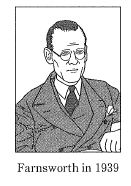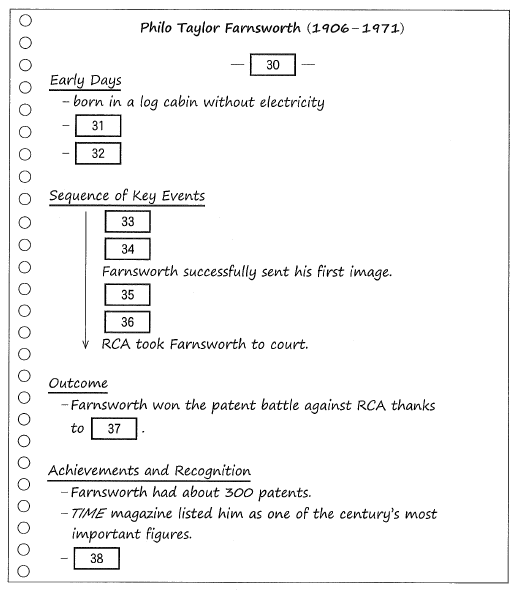問題
In your English class, you will give a presentation about a great inventor. You found the following article and prepared notes for your presentation.

Who invented television? It is not an easy question to answer. In the early years of the 20th century, there was something called a mechanical television system, but it was not a success. Inventors were also competing to develop an electronic television system, which later became the basis of what we have today. In the US, there was a battle over the patent for the electronic television system, which attracted people’s attention because it was between a young man and a giant corporation. This patent would give the inventor the official right to be the only person to develop, use, or sell the system.
Philo Taylor Farnsworth was born in a log cabin in Utah in 1906. His family did not have electricity until he was 12 years old, and he was excited to find a generator─a machine that produces electricity─when they moved into a new home. He was very interested in mechanical and electrical technology, reading any information he could find on the subject. He would often repair the old generator and even changed his mother’s hand-powered washing machine into an electricity-powered one.
One day, while working in his father’s potato field, he looked behind him and saw all the straight parallel rows of soil that he had made. Suddenly, it occurred to him that it might be possible to create an electronic image on a screen using parallel lines, just like the rows in the field. In 1922, during the spring semester of his first year at high school, he presented this idea to his chemistry teacher, Justin Tolman, and asked for advice about his concept of an electronic television system. With sketches and diagrams on blackboards, he showed the teacher how it might be accomplished, and Tolman encouraged him to develop his idea.
On September 7, 1927, Farnsworth succeeded in sending his first electronic image. In the following years, he further improved the system so that it could successfully broadcast live images. The US government gave him a patent for this system in 1930.
However, Farnsworth was not the only one working on such a system. A giant company, RCA However, Farnsworth was not the only one working on such a system. A giant company, RCA (Radio Corporation of America), also saw a bright future for television and did not want to miss the opportunity. They recruited Vladimir Zworykin, who had already worked on an electronic television system and had earned a patent as early as 1923. Yet, in 1931, they offered Farnsworth a large sum of money to sell them his patent as his system was superior to that of Zworykin’s. He refused this offer, which started a patent war between Frahsworth and RCA.
The company took legal action against Farnsworth, claiming that Zworykin’s 1923 patent had priority even though he had never made a working version of his system. Farnsworth lost the first two rounds of the court case. However, in the final round, the teacher who had copied Farnsworth’s blackboard drawings gave evidence that Farnsworth did have the idea of an electronic television system at least a year before Zwoykin’s patent was issued. In 1934, a judge approved Farnsworth’s patent claim on the strength of handwritten notes made by his old high school teacher, Tolman.
Farnsworth died in 1971 at the age of 64. He held about 300 US and foreign patents, mostly in radio and television, and in 1999, TIME magazine included Farnsworth in Time 100: The Most Important People of the Century. In an interview after his death, Farnsworth’s wife Pem recalled Neil Armstrong’s moon landing being broadcast. Watching the television with her, Farnsworth had said, “Pem, this has made it all worthwhile.” His story will always be tied to his teenage dream of sending moving pictures through the air and those blackboard drawings at his high school.
Your presentation notes:

問1 Which is the best subtitle for your presentation? ( 30 )
- A Young Inventor Against a Giant Company
- From High School Teacher to Successful Inventor
- Never-Ending Passion for Generating Electricity
- The Future of Electronic Television
問2 Choose the best two options for ( 31 ) and ( 32 ) to complete Early Days. (The order does not matter.)
- bought a generator to provide his family with electricity
- built a log cabin that had electricity with the help of his father
- enjoyed reading books on every subject in school
- fixed and improved household equipment for his family
- got the idea for an electronic television system while working in a field
問3 Choose four out of the five events (1~5) in the order they happened to complete Sequence of Key Events.
( 33 )→( 34 )→( 35 )→( 36 )
- Farnsworth rejected RCA’s offer.
- Farnsworth shared his idea with his high school teacher.
- RCA won the first stage of the battle.
- The US government gave Farnsworth the patent.
- Zworykin was granted a patent for his television system.
問4 Choose the best option for ( 37 ) to complete Outcome.
- the acceptance of his rival’s technological inferiority
- the financial assistance provided by Tolman
- the sketches his teacher had kept for many years
- the withdrawal of RCA from the battle
問5 Choose the best option for ( 38 ) to complete Achievements and Recognition.
- He and his wife were given an award for their work with RCA.
- He appeared on TV when Armstrong’s first moon landing was broadcast.
- His invention has enabled us to watch historic events live.
- Many teenagers have followed their dreams after watching him on TV.
【解説】問1
Which is the best subtitle for your presentation? ( 30 )
あなたのプレゼンテーションに最適なサブタイトルはどれですか。
タイトルを答える問題は、全体を読んでからした方がよいです。なので問1ですが、解くのは最後でいいのではないでしょうか。
選択肢を確認しましょう。
1. A Young Inventor Against a Giant Company
巨大企業に対抗した若き発明家
2. From High School Teacher to Successful Inventor
高校教師から成功した発明家へ
3. Never-Ending Passion for Generating Electricity
発電に対する終わりのない情熱
4. The Future of Electronic Television
電子テレビの未来
( 30 )は Phlo Taylor Farnsworth (1906~1971) というメインタイトルの下の、サブタイトルの位置にあります。つまり Phlo Taylor Farnsworth がどういう人物かを表すものが入りそうです。
それを踏まえて選択肢を見てみると、「2」はあり得ませんね。Farnsworth は高校教師になったことはありません。また本文は Farnsworth の伝記みたいなものですから、「4」もずれています。
「3」に関連していそうなことは、第二段落にこうあります。
he was excited to find a generator─a machine that produces electricity
彼は発電機、つまり電気を生成する機械を見つけて興奮していました
これは子供時代のエピソードの一つで、第三段落以降はテレビの発明に関する話が中心になります。この選択肢は違いますね。
ということで正解は「1」です。

Farnsworth って誰? と聞かれたら「巨大企業に対抗した若き発明家だよ」と答えるのが自然ですよね。
【解説】問2
Choose the best two options for ( 31 ) and ( 32 ) to complete Early Days. (The order does not matter.)
Early Days を完成させるために( 31 )と( 32 )に入れる、もっともよい二つの選択肢を選べ(順序は関係ありません)
Early Days とありますので、Farnsworth の若かりし頃の部分を読んで答えればよいです。
第二段落では「12 years old」とあります。第三段落には「In 1922」とあります。Farnsworth が生まれたのが 1906年ですから、まだ16歳です。この辺りまでがこの問題の該当部分になります。
1. bought a generator to provide his family with electricity
家族に電気を供給するために発電機を購入しました
「発電機」に関しては、第二段落にこうあります。
he was excited to find a generator─a machine that produces electricity─when they moved into a new home.
彼は新しい家に引っ越したときに、発電機(電気を生成する機械)を見つけて興奮していました。
引っ越し先に新しい家に発電機があったんですね。Farnsworth が買ってきたんじゃありません。この選択肢は違います。
2. built a log cabin that had electricity with the help of his father
父親の助けを借りて、電気のある丸太小屋を建てた
「丸太小屋」に関しては、第二段落にこうあります。
Philo Taylor Farnsworth was born in a log cabin in Utah in 1906.
フィロ・テイラー・ファーンズワースは1906年にユタ州の丸太小屋で生まれました
丸太小屋で生まれたのであって、丸太小屋を建ててはいませんね。この選択肢は違います。
3. enjoyed reading books on every subject in school
学校であらゆる科目に関する本を読んで楽しんだ
subject に関して、第二段落にこうあります。
He was very interested in mechanical and electrical technology, reading any information he could find on the subject.
彼は機械的および電気的技術に非常に興味があり、この内容に関して見つけたどんな情報も読んでいました。
読んでいたのは「機械・電気技術」に関する内容です。選択肢の「every subject / すべての教科」ではありません。この選択肢も違います。
4. fixed and improved household equipment for his family
家族のために家庭用機器の修理や改良をした
「修理」や「改良」に関しては、第二段落にこうあります。
He would often repair the old generator and even changed his mother’s hand-powered washing machine into an electricity-powered one.
彼はしばしば古い発電機を修理し、母親の手動式洗濯機を電気式の洗濯機に変えさえしました。
選択肢の「fixed / improved」と、本文の「repair / changed」が対応しています。この選択肢が正解です。
5. got the idea for an electronic television system while working in a field
畑で働きながら電子テレビシステムのアイデアを思いついた
field に関しては、第三段落の最初にこうあります。
One day, while working in his father’s potato field, he looked behind him and saw all the straight parallel rows of soil that he had made.
ある日、父親のじゃがいも畑で働いていると、彼は後ろを振り返り、自分が作ったすべての真っ直ぐな平行な土の列を見ました。
そしてこう続きます。
Suddenly, it occurred to him that it might be possible to create an electronic image on a screen using parallel lines, just like the rows in the field.
突然、畑の列のように平行線を使用して、画面上に電子画像を作成できる可能性に気づきました。
働いていた畑でテレビのアイデアを思いついていますね。この選択肢も正解です。
ということで正解は「4」「5」です。

第四段落の最初に「1927」とあります。このときファーンズワースは21歳です。若いと言えば若いんですが、いったんここでストップして、その前の第二第三段落の内容を踏まえて、問2に取り組むのがいいんじゃないでしょうか
【解説】問3
Choose four out of the five events (1~5) in the order they happened to complete Sequence of Key Events.
Sequence of Key Events を完成させるために、起こった順番に5つの出来事(1~5)から4つを選べ。
Your presentation notes: の Sequence of Key Events の部分を確認しましょう。
( 33 )
( 34 )
Farnsworth successfully sent his first image.
( 35 )
( 36 )
RCA took Fransworth to court.
こうなっています。まずは「Farnsworth successfully sent his first image. / ファーンズワースは彼の最初の画像を送るのに成功した」の前に起こったことを、選択肢から選べばよさそうですね。
「最初の画像」に関しては、第四段落の最初にこうあります。
On September 7, 1927, Farnsworth succeeded in sending his first electronic image.
1927年9月7日、ファーンズワースは最初の電子画像の送信に成功しました。
ということで、第三段落までの内容を踏まえて選択肢を確認すると、選択肢「2」の内容が、第三段落ですでに出てきていました。
選択肢「2」はこうです。
2. Farnsworth shared his idea with his high school teacher.
ファーンズワースは彼の考えを高校の先生と共有しました。
そして第三段落に書かれてあるのは、これです。
In 1922, during the spring semester of his first year at high school, he presented this idea to his chemistry teacher, Justin Tolman, and asked for advice about his concept of an electronic television system.
1922年、高校1年の春学期に、彼はこのアイデアを化学の教師である Justin Tolman に提示し、電子テレビシステムの概念についてアドバイスを求めました。
ということで選択肢「2」が、( 33 )か( 34 )のどちらかに入るとわかります。ところがその他の選択肢を見ても、聞いたことがないような話ばかりです。仕方がないので、本文を読み進めていきましょう。
すると第四段落の続きにこうあります。
The US government gave him a patent for this system in 1930.
米国政府は1930年に彼にこのシステムの特許を与えました。
この内容は、選択肢「4」の内容に合致します。
4. The US government gave Farnsworth the patent.
米国政府はファーンズワースに特許を与えた。
ということで、( 35 )→「4」とわかります。
さらに本文を進めていくと、第五段落にこうあります。
They recruited Vladimir Zworykin, who had already worked on an electronic television system and had earned a patent as early as 1923.
彼らは ウラジミールズヴォリキンを採用しました。彼はすでに電子テレビシステムに取り組んでおり、早くも1923年に特許を取得していたいました。
これは選択肢「5」の内容です。
5. Zworykin was granted a patent for his television system.
ズウォリキンは彼のテレビシステムの特許を取得しました。
本文に「1923年」という年号が出てきました。最初に確認しましたが、ファーンズワースが最初の電子画像の送信に成功したのは、1927年です。つまりズウォリキンの特許の方が早いんですね。
ただ、選択肢「2」の内容は「1922年」ですので、こちらよりは遅いです。これで( 33 )→「2」、( 34 )→「5」がわかりました。
残りは( 36 )です。これは「RCA took Fransworth to court. / RCAはフランズワースを法廷に連れて行った」の前にあたります。「法廷に連れていく」というのは、もちろん「裁判に訴えた」ということです。
それを踏まえて選択肢「1」と「3」を比べると、本文を確認するまでもなくわかります。
1. Farnsworth rejected RCA’s offer.
ファーンズワースはRCAの申し出を拒否した。
3. RCA won the first stage of the battle.
RCAは争いの最初のステージで勝利しました。
普通に考えて、「申し出を拒否した」→「訴えた」→「RCAが勝った」という流れでしょう。念のため本文を確認すると、第五段落の内容は、こう続きます。
Yet, in 1931, they offered Farnsworth a large sum of money to sell them his patent as his system was superior to that of Zworykin’s.
しかし、ファーンズワースのシステムはズウォリーキンのシステムよりも優れていたため、1931年に彼らはファーンズワースに彼の特許を売るようにと多額の資金を申し入れました。
RCA は特許を買いたいと、ファーンズワースに申し入れたんですね。そしてこうなります。
He refused this offer, which started a patent war between Frahsworth and RCA.
彼はこの申し出を拒否し、ファーンズワースと RCA の間の特許戦争がはじまりました。
ファーンズワースはその RCA の申し出を拒否したんですね。これは選択肢「1」の内容です。
1. Farnsworth rejected RCA’s offer.
ファーンズワースはRCAの申し出を拒否した。
これで( 36 )→「1」とわかりました。ちなみに選択肢「3」の RCA が第一審で勝利した内容は、第六段落にあります。
Farnsworth lost the first two rounds of the court case.
ファーンズワースは、訴訟の最初の2ラウンドを失った
訴訟の後の話ですから、「3」が選ばれない選択肢になります。
まとめますとこのような時系列になります。
2. Farnsworth shared his idea with his high school teacher. (1922年)
5. Zworykin was granted a patent for his television system. (1923年)
Farnsworth successfully sent his first image. (1927)
4. The US government gave Farnsworth the patent. (1930)
1. Farnsworth rejected RCA’s offer (1931)
RCA took Fransworth to court.
3. RCA won the first stage of the battle.
ということで正解は「2」→「5」→「4」→「1」です。

本文に書かれてある順番にならない選択肢が一部あります。去年もそういうものがありました。出てきた年号に印をしておくなどして、後で確認しやすいような工夫が必要ですね。
【解説】問4
Choose the best option for ( 37 ) to complete Outcome.
Outcome を完成させるために、( 37 )に対する最も良い選択肢を選べ
Outcome にある文章を確認しましょう。
Farnsworth won the patent battle against RCA thanks to ( 37 ).
ファーンズワースは ( 37 ) のおかげでRCAとの特許争いに勝ちました。
ファーンズワースはなぜ、RCA との裁判に勝つことができたのでしょうか。確かに気になりますね。RCA との訴訟に関しては、第六段落にあります。
However, in the final round, the teacher who had copied Farnsworth’s blackboard drawings gave evidence that Farnsworth did have the idea of an electronic television system at least a year before Zwoykin’s patent was issued.
しかし、ファーンズワースの黒板の絵をコピーしていた教師は、ファーンズワースがズウォリーキンの特許が発行される少なくとも1年前に、電子テレビシステムのアイデアを持っていたという証拠を、最終ラウンドで示しました。
そしてこう続きます。
In 1934, a judge approved Farnsworth’s patent claim on the strength of handwritten notes made by his old high school teacher, Tolman.
1934年、高校時代の恩師であるトールマンが書いた手書きのメモの力によって、裁判官はファーンズワースの特許の主張を承認しました。
第三段落で高校の先生とこういう話がありました。
With sketches and diagrams on blackboards, he showed the teacher how it might be accomplished, and Tolman encouraged him to develop his idea.
黒板に書いた絵や図を使って、彼はそれがどのように達成されるかを教師に示しました。トールマンは彼にアイデアを発展させるように勧めました。
この話が、この裁判につながってくるんですね。ということでなぜ裁判に勝つことができたかがわかりました。では選択肢を確認していきましょう。
1. the acceptance of his rival’s technological inferiority
彼のライバルが技術的に劣るのを受け入れたこと
2. the financial assistance provided by Tolman
トールマンが提供する財政援助
3. the sketches his teacher had kept for many years
彼の先生が何年もの間保管していたスケッチ
4. the withdrawal of RCA from the battle
争いからの RCA の撤退
高校の時の先生が持っていたスケッチによって裁判に勝てたので、正解は「3」です。

まさか、高校時代のエピソードがここにつながるとは思いませんでしたね。すごい伏線回収でした。ちょっとした法廷物の映画を見た気分です。
【解説】問5
Choose the best option for ( 38 ) to complete Achievements and Recognition.
( 38 )に最も良い選択肢を選んで、Achievements and Recognition を完成させなさい。
Achievements and Recognition には三つ項目があり、そのうち二つがすでに書かれてあります。まずはその二つを確認してみましょう。
Farnsworth had about 300 patents.
ファーンズワースには約300件の特許がありました。
それに関する内容は、第七段落にこうあります。
He held about 300 US and foreign patents, mostly in radio and television,
彼は主にラジオとテレビで約300の、米国および外国の特許を取得した
Time magazine listed him as one of the century’s most important figures.
タイム誌は彼を今世紀の最も重要な人物の一人として挙げました。
それに関する内容は、第七段落の続きにこうあります。
and in 1999, TIME magazine included Farnsworth in Time 100: The Most Important People of the Century.
1999年にタイム誌は、タイム100という今世紀の最も重要な人々の中に、ファーンズワースを入れました。
これに並ぶような話を選択肢から選べばよいのです。では選択肢を確認してみましょう。
1. He and his wife were given an award for their work with RCA.
彼と彼の妻は RCA での彼らの仕事に対して賞を与えられました。
RCA とは特許について裁判で争った関係です。この選択肢は違います。
2. He appeared on TV when Armstrong’s first moon landing was broadcast.
アームストロングの最初の月面着陸が放送されたとき、彼はテレビに出演しました。
月面着陸に関しては、第七段落にこうあります。
In an interview after his death, Farnsworth’s wife Pem recalled Neil Armstrong’s moon landing being broadcast. Watching the television with her, Farnsworth had said, “Pem, this has made it all worthwhile.”
ファーンズワースの妻ペムは、彼の死後のインタビューで、ニールアームストロングの月面着陸が放送されたことを思い出しました。彼女と一緒にテレビを見て、ファーンズワースは「ペム、これですっかり価値のあるものになった」と言った。
this has made it all worthwhile. という表現がよくわからないと思います。指示語が何を指しているのかを確認しましょう。まず this は「月面着陸が放送されていること」を指しています。it は「彼がやってきたこと」を指しています。
つまり、「月面着陸の放送」が「彼のやってきたこと」を価値あるものにした→「月面着陸の放送」のおかげで「彼のやってきたこと」が価値あるものになった→「やってきたことが報われたなぁ」という感じになります。
似たような形の表現に「I’ll make it worth your while. / 相当の報酬は出します」があります。
話が横にそれましたが、ファーンズワースは「月面着陸の放送」をテレビで見ていました。出演してはいませんね。この選択肢は違います。
3. His invention has enabled us to watch historic events live.
彼の発明により、私たちは歴史的な出来事をライブで見ることができるようになりました。
先程確認したとおり、「月面着陸の放送」を見て、ファーンズワースは、やってきたことが報われたと感じました。逆に考えると、ファーンズワースの発明のおかげで、「月面着陸」という歴史的な出来事がテレビで見られるようになったのです。
この選択肢が正解です。
4. Many teenagers have followed their dreams after watching him on TV.
多くのティーンエイジャーは、テレビで彼を見た後、彼らの夢を追いました。
teenage に関しては、本文の最後にこうあります。
His story will always be tied to his teenage dream of sending moving pictures through the air and those blackboard drawings at his high school.
彼の物語は、絵を空中で送るという彼の10代の夢と、高校で黒板に描いたものが常に結びつくでしょう。
わかりづらい文ですが、とりあえずファーンズワースがテレビに出たという話はありませんでした。この選択肢は違いますね。
ということで正解は「3」です。

「1」は明らかに違いますし、「2」「4」に関しては、ファーンズワースがテレビに出ていないことを意識すれば、消すことができます。「3」自体はそう直接的に書かれていないので選びづらいですが、消去法で他の選択肢を消していきましょう。



コメントをどうぞ